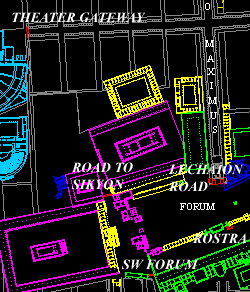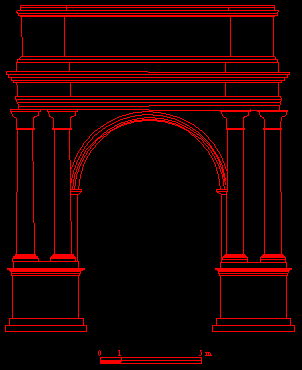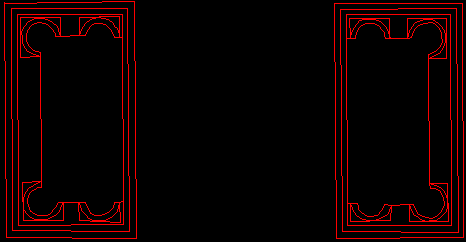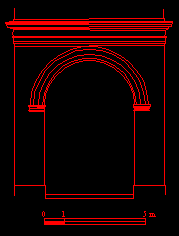|
Monumental
Arches
|
There are four monumental
arches from the area of the Roman forum and and one monumental
gateway from the area of the theater. Seen in red in the diagram
at the right, the arches and gateway are summarized below.
Arch Locations:
Building summaries
written by Guido Petruccioli.
|

Figure 1
Location of the Monumental
Arches in Corinth, A.D. 150.
|



| Arch
at the Head of the Lechaion Road
The monumental arch
at the head of the Lechaion Road stands in a commanding position
at the place where the cardo maximus of the Roman colony meets
the forum from the north. On high ground the arch commands the
view to the north towards the Corinthian Gulf a distance of approximately
3000 m. This arch was by far the largest and most impressive arch
from the Roman city.
The most recent
study of this monumental arch was undertaken by Charles M. Edwards
and published in Hesperia in 1994. The following summary is based
on his work. The arch was originally constructed as a triple bayed
arch and subsequently restored as a single bayed arch.
|

Figure 2
Elevation of the Lechaion Road Arch
in Corinth, A.D. 150.
|
- Phase I: In the Augustan
period the central bay was accessed through a ramp from the north
while pedestrians walked over flanking steps and through the side
openings. The width of the arch would have been in excess of 20 m.
The central opening had columns on podia projecting north.
- Phase II: In the late
third or early fourth quarter of the first century A.D. the pylons
were enlarged on the south side of the arch and the central bay was
enlarged to a span of 7 m. A long flight of steps replaced the ramp
on the north side of the arch which meant that only pedestrians could
access the forum through the arch from this time on.
- Phase III: A platform
and a crosswalk on the eastern side of the arch signifies the third
phase of construction. The chronology is less certain but probably
during the late Roman or early Byzantine period.

Figure 3
Site plan of the Lechaion Road Arch in Corinth,
A.D. 150.
|
Arch Near
the Rostra
This monumental arch
was located next to the Rostra on the eastern staircase that connected
the lower forum to the higher level. This pedestrian passageway
was on axis with the Lechaion Road and therefore the continuation
of the cardo maximus within the center of the city and adjacent
to the Rostra. A single bay arch has been restored in this location
of ca. 3m. span. Few remains of this arch survive and therefore
the details of its construction are vague. A likely date for the
construction of the arch would be the Augustan period.
|

Figure 4
Elevation of the Rostra Arch in Corinth, A.D. 150.
|
|
Arch
at the Southwest Forum
A building located
in the southwest corner of the forum and named by the excavator
the "Long Rectangular Building," was constructed during the reign
of Nero or possibly Vespasian. Immediately to the east of the
building exist the foundations of a monumental arch that connect
it to the South Stoa. The arch was a single span arch with a width
of 4.50 m.
Although the chronological
relationship of the arch to the "Long Rectangular Building" is
not absolutely certain it is most likely that the arch was constructed
as a part of the same building campaign. This arch was used for
pedestrian as well as wheeled traffic.
|

Figure
5
Elevation of the Southwest Arch in Corinth, A.D.
150.
|
Arch
on the Road to Sikyon
At the northwest corner
of the forum where the road to Sikyon exits the area there is the location
of a triple bayed arch connecting the colonnade of the Northwest Stoa
to the Precinct of Temple C. Cuttings in the bedrock exist to show that
the structure was supported by piers. The lateral openings had a span
of 1.60 m. and the central opening was 4.25 m. Based on the relative
chronology of the Northwest Stoa and Temple C it is most likely that
the arch was constructed in the early Augustan period.
Gateway at the Theater
A monumental gateway was
situated to the north and east of the theater where Decumanus
II North meets the pavement of the theater. Since only a portion
of the width of the roadway has been excavated the original width of
the gateway is not known although two of the pier foundations survive,
2.25 m. wide.
Testimonia:
Bibliography:
- Edwards, Charles M.,
"The Arch over the Lechaion Road at Corinth and its Sculpture," Hesperia
63 (1994) pp. 263-308.
- Scranton, R.L. Corinth
I, iii; Monuments in the Lower Agora and North of the Archaic Temple.
Princeton, 1951, pp. 133-134, 137-139.
- Stillwell, Richard,
R.L. Scranton, and S.E. Freeman. Corinth I, ii; Architecture.
Cambridge, 1941, pp. 159-192.
- Williams, Charles K.
II and Joan E. Fisher, "Corinth 1975: Forum Southwest," Hesperia
45 (1976) pp. 99-162.
- Williams, Charles K.
II and Orestes H. Zervos, "Corinth 1982: East of the Theater," Hesperia
52 (1983) pp. 1-47.
|








